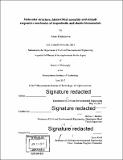| dc.contributor.advisor | Markus J. Buehler. | en_US |
| dc.contributor.author | Tarakanova, Anna | en_US |
| dc.contributor.other | Massachusetts Institute of Technology. Department of Civil and Environmental Engineering. | en_US |
| dc.date.accessioned | 2017-09-15T15:34:04Z | |
| dc.date.available | 2017-09-15T15:34:04Z | |
| dc.date.copyright | 2017 | en_US |
| dc.date.issued | 2017 | en_US |
| dc.identifier.uri | http://hdl.handle.net/1721.1/111435 | |
| dc.description | Thesis: Ph. D., Massachusetts Institute of Technology, Department of Civil and Environmental Engineering, 2017. | en_US |
| dc.description | Cataloged from PDF version of thesis. | en_US |
| dc.description | Includes bibliographical references. | en_US |
| dc.description.abstract | The elastin polymer, assembled from its molecular precursor tropoelastin, is the dominant component of elastic fibers, which confer elasticity and structural integrity to skin, lung, connective and vascular tissue. Historically, elastin's dynamic nature has precluded traditional approaches such as X-ray crystallography to understand its detailed features. Solving tropoelastin's atomistic structure is key to characterizing elastin's complex biological function, disease-related mechanisms associated with mutations therein, and assembly process, to replicate natural function upon impairment. From the materials perspective, elastin-based materials display tunable thermal sensitivity, presenting opportunities to mimic and control these responsive features for biomedical applications. First, we develop and validate an elastic network model of tropoelastin based on small-angle X-ray scattering to realize near-equilibrium dynamics. We identify a geometry-driven lock-and-key mechanism implicated in cell binding and multi-molecular assembly. We introduce a constitutively quiescent domain to explain the effect of local stiffness perturbation on dynamics, reconciling the contradictory needs for overall structural flexibility and the organizational requirement of specific domains towards protein self-assembly. Second, we develop an atomistic model of tropoelastin and validate it against experimental data. We introduce artificial mutations to probe the function of key molecular regions and cutis laxa-associated mutations to study disease etiology. We reveal mechanisms behind variation in structure and hierarchical assembly based on molecular geometry, secondary structure, location and exposure of hydrophobic domains, and dynamic models, correlating these with experimental results, to build a foundation for studying elastin mechanics, assembly, and disease. Third, we characterize the temperature response spectrum of elastin-like peptides to design synthetic polymers with tunable switching. We resolve the effect of peptide chemistry, chain length, and solvent environment on structural transitions, based on local molecular structure, peptide dynamics and interaction with nearest hydration shells. We build a model for a chimera silk-elastin-like protein polymer combining silk's strength with elastin's extensibility and responsive features to study temperature transition effects on molecular-scale mechanics. Simulating molecular unfolding pathways, we analyze the associated free-energy landscape with the Bell-Evans model to interpret temperature-induced phase transitions. We develop a feedback loop between simulation and experiment for predictive biomaterial design, enabling new applications in drug delivery and tissue engineering. | en_US |
| dc.description.statementofresponsibility | by Anna Tarakanova. | en_US |
| dc.format.extent | 248 pages | en_US |
| dc.language.iso | eng | en_US |
| dc.publisher | Massachusetts Institute of Technology | en_US |
| dc.rights | MIT theses are protected by copyright. They may be viewed, downloaded, or printed from this source but further reproduction or distribution in any format is prohibited without written permission. | en_US |
| dc.rights.uri | http://dspace.mit.edu/handle/1721.1/7582 | en_US |
| dc.subject | Civil and Environmental Engineering. | en_US |
| dc.title | Molecular structure, hierarchical assembly and stimuli-responsive mechanics of tropoelastin and elastin biomaterials | en_US |
| dc.type | Thesis | en_US |
| dc.description.degree | Ph. D. | en_US |
| dc.contributor.department | Massachusetts Institute of Technology. Department of Civil and Environmental Engineering | |
| dc.identifier.oclc | 1003292655 | en_US |
